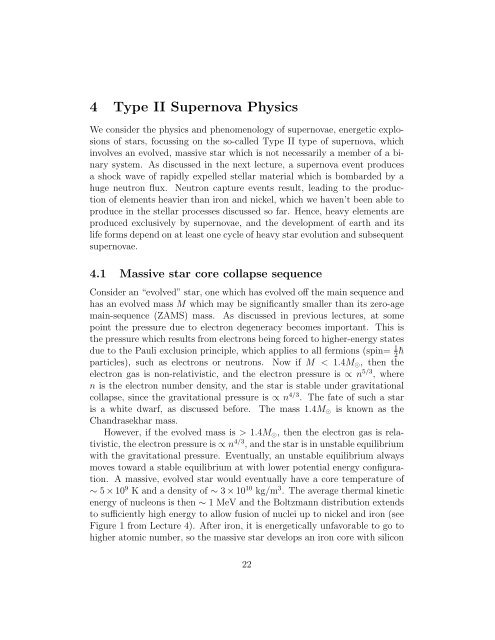Lecture Notes for Astronomy 321, W 2004 1 Stellar Energy ...
Lecture Notes for Astronomy 321, W 2004 1 Stellar Energy ...
Lecture Notes for Astronomy 321, W 2004 1 Stellar Energy ...
You also want an ePaper? Increase the reach of your titles
YUMPU automatically turns print PDFs into web optimized ePapers that Google loves.
4 Type II Supernova Physics<br />
We consider the physics and phenomenology of supernovae, energetic explosions<br />
of stars, focussing on the so-called Type II type of supernova, which<br />
involves an evolved, massive star which is not necessarily a member of a binary<br />
system. As discussed in the next lecture, a supernova event produces<br />
a shock wave of rapidly expelled stellar material which is bombarded by a<br />
huge neutron flux. Neutron capture events result, leading to the production<br />
of elements heavier than iron and nickel, which we haven’t been able to<br />
produce in the stellar processes discussed so far. Hence, heavy elements are<br />
produced exclusively by supernovae, and the development of earth and its<br />
life <strong>for</strong>ms depend on at least one cycle of heavy star evolution and subsequent<br />
supernovae.<br />
4.1 Massive star core collapse sequence<br />
Consider an “evolved” star, one which has evolved off the main sequence and<br />
has an evolved mass M which may be significantly smaller than its zero-age<br />
main-sequence (ZAMS) mass. As discussed in previous lectures, at some<br />
point the pressure due to electron degeneracy becomes important. This is<br />
the pressure which results from electrons being <strong>for</strong>ced to higher-energy states<br />
due to the Pauli exclusion principle, which applies to all fermions (spin= 1 2¯h<br />
particles), such as electrons or neutrons. Now if M < 1.4M ⊙ , then the<br />
electron gas is non-relativistic, and the electron pressure is ∝ n 5/3 , where<br />
n is the electron number density, and the star is stable under gravitational<br />
collapse, since the gravitational pressure is ∝ n 4/3 . The fate of such a star<br />
is a white dwarf, as discussed be<strong>for</strong>e. The mass 1.4M ⊙ is known as the<br />
Chandrasekhar mass.<br />
However, if the evolved mass is > 1.4M ⊙ , then the electron gas is relativistic,<br />
the electron pressure is ∝ n 4/3 , and the star is in unstable equilibrium<br />
with the gravitational pressure. Eventually, an unstable equilibrium always<br />
moves toward a stable equilibrium at with lower potential energy configuration.<br />
A massive, evolved star would eventually have a core temperature of<br />
∼ 5 × 10 9 K and a density of ∼ 3 × 10 10 kg/m 3 . The average thermal kinetic<br />
energy of nucleons is then ∼ 1 MeV and the Boltzmann distribution extends<br />
to sufficiently high energy to allow fusion of nuclei up to nickel and iron (see<br />
Figure 1 from <strong>Lecture</strong> 4). After iron, it is energetically unfavorable to go to<br />
higher atomic number, so the massive star develops an iron core with silicon<br />
22













